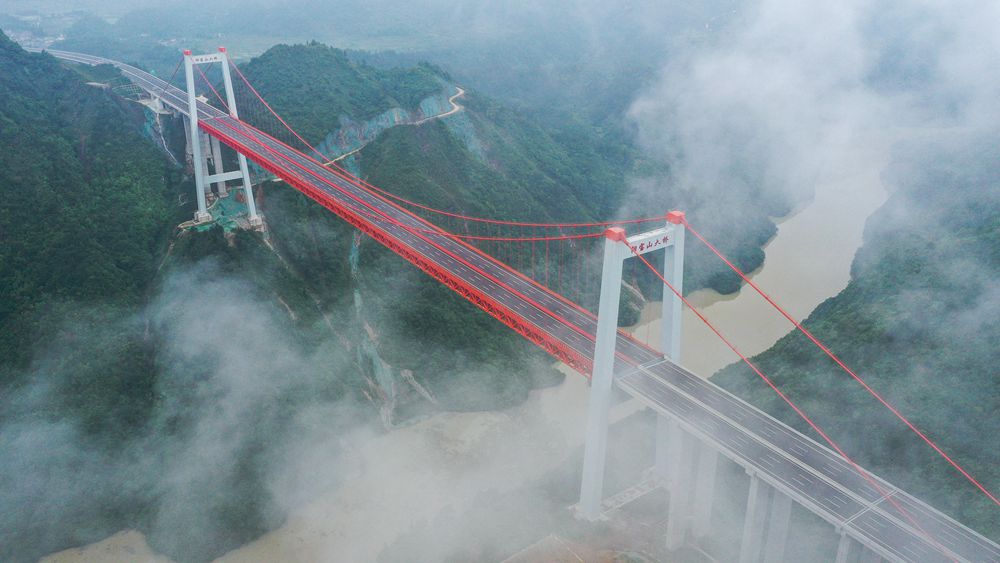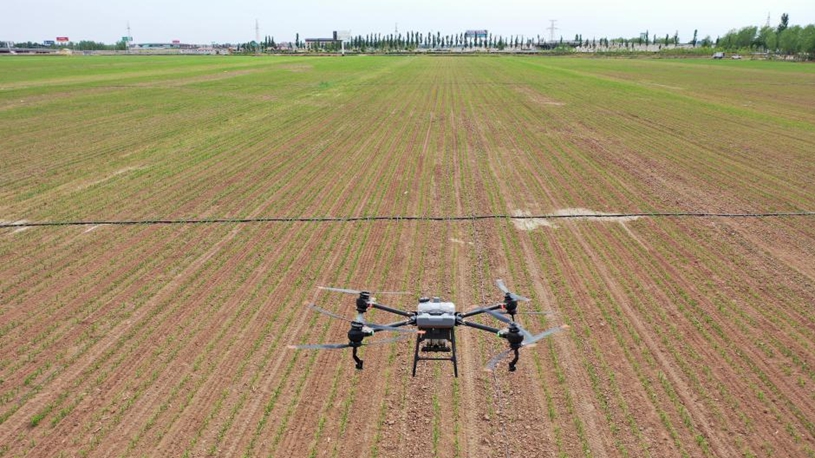* The Tarim Desert Road in northwest China's Xinjiang Uygur Autonomous Region has been turned into a zero-carbon one, thanks to a transformation project completed Thursday for the irrigation system along its shelterbelt.
* The project is estimated to cut diesel consumption by about 1,000 tonnes and carbon dioxide emissions by 3,410 tonnes per year.
* The zero-carbon road is an example of China's bid to achieve carbon peaking by 2030 and carbon neutrality by 2060.
by Xinhua writers Zhang Yuyang, Gu Yu, Su Chuanyi
URUMQI, June 4 (Xinhua) -- The Tarim Desert Road, which traverses the Taklimakan Desert in northwest China's Xinjiang Uygur Autonomous Region, has been turned into a zero-carbon one, thanks to a transformation project completed Thursday for the irrigation system along its shelterbelt.
After the transformation project, shrubs along the road are now irrigated with the help of solar power-fueled pumps, instead of diesel ones.
The project is estimated to cut diesel consumption by about 1,000 tonnes and carbon dioxide emissions by 3,410 tonnes per year, according to PetroChina's Tarim oilfield branch, which is in charge of the project.

Aerial photo taken on Aug. 12, 2019 shows the Tarim Desert Road traversing through the Taklimakan Desert and the shelterbelt planted along it in northwest China's Xinjiang Uygur Autonomous Region. (Xinhua/Gu Yu)
THE GREEN SHIFT
The Tarim Desert Road was completed in 1995. Cutting through China's largest desert, it reduced the distance from the regional capital Urumqi to Hotan by 500 km.
However, it was no easy task to build and maintain a road in the Taklimakan, the world's second-largest shifting-sand desert. In 2005, a 436-km-long shelterbelt was planted on both sides of the road to protect it from being swallowed up by sand, and 109 well stations were built for irrigation.
Eighty-six of the well stations were powered by diesel fuel. They were also unable to provide continuous energy.

A worker checks the drip irrigation facilities outside a well station along the Tarim Desert Road in northwest China's Xinjiang Uygur Autonomous Region, May 29, 2022. (Xinhua)
In January this year, PetroChina's Tarim oilfield branch launched the transformation project, which sought to alter all the diesel power generators into photovoltaic power-driven ones.
In addition to the diesel consumption and CO2 emissions reduced with the help of the project, CO2 captured by the shelterbelt can surpass 20,000 tonnes each year. It can help neutralize the CO2 emitted by passing vehicles, thus making it a zero-carbon road, according to the branch.
The solar power generators are also equipped with energy storage facilities, which ensure a stable power supply and provide the maintenance workers with accessible electricity.

Aerial photo taken on May 29, 2022 shows workers of PetroChina's Tarim oilfield branch installing photovoltaic panels at a well station along the Tarim Desert Road in northwest China's Xinjiang Uygur Autonomous Region. (Xinhua)
THE "GREEN-FINGERED"
In addition to meticulous planning by local governments and the Tarim oilfield branch, the desert road has reached its zero-carbon goal thanks to the "green-fingered" researchers and maintenance workers.
Chang Qing's devotion to the road began long before it was built.
In 1991, Chang and her colleagues were dispatched to the Taklimakan Desert. Their task was to select vegetation for the shelterbelt along the road, a key step to protecting it from the raging sandstorms.
Chang, now a senior engineer at the Xinjiang Institute of Ecology and Geography under the Chinese Academy of Sciences, recalled that their lab was a semi-subterranean pit encircled by walls made of mud and hay, and that the salty water was their only means of staying hydrated.

Workers clean photovoltaic panels along the Tarim Desert Road in northwest China's Xinjiang Uygur Autonomous Region, May 29, 2022. (Xinhua)
Through unremitting efforts, researchers in the desert identified new irrigation methods and ideal vegetation for preventing sandstorms and capturing CO2.
Compared with Chang, Xu Bo is a latecomer. When he kicked off his career as a forest ranger in 2004, the shelterbelt was but a batch of saplings.
In the course of his 18 years guarding the shelterbelt, Xu frequently consulted experts for advice and carried out numerous experiments to protect the plants. During this process, he suffered injuries to the eyes, hands and ankles due to the harsh conditions in the Taklimakan.

Workers of PetroChina's Tarim oilfield branch set up photovoltaic equipment along the Tarim Desert Road in northwest China's Xinjiang Uygur Autonomous Region, March 20, 2022. (Xinhua/Gu Yu)
Now, he has become so familiar with his "green wall" that if anything goes wrong with any part of the shelterbelt, he can spot it at a single glance.
Both Chang and Xu are 59 years old and will reach retirement in a year or two. But neither has any intention to put an end to their dedication. "For me, blanketing the desert in green is a romantic cause worthy of lifelong devotion," Chang said.

Aerial photo taken on Aug. 22, 2021 shows heliostats at a photothermal power station in Hami, northwest China's Xinjiang Uygur Autonomous Region. (Xinhua/Gao Han)
THE GREEN PATH
The zero-carbon road is just another example of China's bid to achieve carbon peaking by 2030 and carbon neutrality by 2060.
With abundant new energy resources such as wind and solar energy, Xinjiang is a large-scale national clean energy base.
During the first 10 months last year, Xinjiang's solar and wind power generation amounts grew 22 percent and 25.3 percent year on year to 15.92 billion kWh and 47.09 billion kWh, official data shows.

Aerial photo taken on Aug. 22, 2021 shows a photothermal power station in Hami, northwest China's Xinjiang Uygur Autonomous Region. (Xinhua/Gao Han)
Through 2025, Xinjiang will introduce nearly 10 billion yuan (about 1.5 billion U.S. dollars) of technological investment and incubate nearly 30 entities for innovation and entrepreneurship related to carbon reduction.
Since its construction, the Tarim Desert Road has facilitated transportation and boosted the livelihoods of local people. Now, the road stands as a testimony to China's commitment to honoring its carbon goals. ■
(Video reporters: Su Chuanyi, Gu Yu, Zhang Yuyang; Video editors: Zhou Sa'ang, Zhang Yucheng.)












